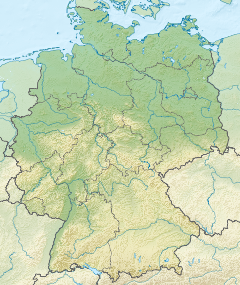Hohler Fels

The entrance of the Hohle Fels cave
|
|
| Location | Schelklingen, Baden-Württemberg, Germany |
|---|---|
| Region | Ach Valley, Swabian Jura |
| Coordinates | 48°22′45″N 9°45′20″E / 48.37917°N 9.75556°ECoordinates: 48°22′45″N 9°45′20″E / 48.37917°N 9.75556°E |
| History | |
| Periods | Upper Paleolithic |
| Cultures | Aurignacian |
The Hohle Fels (German pronunciation: [ˈhoːləˈfɛls]) (also Hohlefels, Hohler Fels, German for "hollow rock") is a cave in the Swabian Jura of Germany that has yielded a number of important archaeological finds dating to the Upper Paleolithic. Artifacts found in the cave represent some of the earliest examples of prehistoric art and musical instruments ever discovered. The cave is just outside the town of Schelklingen in the state of Baden-Württemberg, near Ulm.
The cave entrance is at 534 m (1,752 ft) above sea level. The cave consists of a tunnel of about 15 m (49 ft) length and a main hall with a volume of 6,000 m3 (210,000 cu ft), making the cave hall one of the largest of Southern Germany.
The first excavation took place in 1870, yielding remnants of cave bears, reindeer, mammoths and horses as well as tools belonging to the Aurignacian culture of the Upper Paleolithic.
Further excavations during 1958 to 1960, 1977, and 2002 yielded a number of spectacular finds, including several specimens of prehistoric sculpture such as an ivory bird and a human-lion hybrid figure similar to the Löwenmensch figurine but only 2.5 cm tall. In 2005, one of the oldest phallic representations was discovered.
...
Wikipedia


